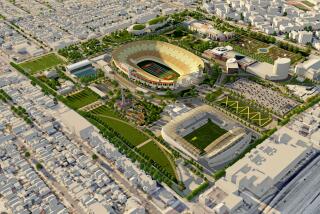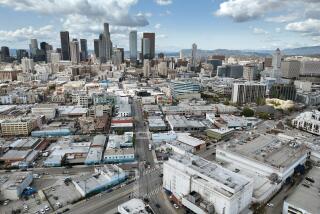Mall Raises the Roof : Retailing: The new owners of the Promenade in Warner Center pin their hopes on a renovation to woo back shoppers. Some observers see risks.
The Promenade Mall opened in Woodland Hills’ Warner Center in 1973 in an attempt to be an upscale shopper’s dream, the west San Fernando Valley’s answer to Rodeo Drive. It had Saks Fifth Avenue, Robinson’s, Bullock’s Wilshire (now I. Magnin) and a host of stylish shops. For a while, the idea worked.
But by the late 1980s, the Promenade had lost its luster, the victim of neglect in an ever-changing, fiercely competitive marketplace. It still had such popular, high-end retailers as Ann Taylor, Williams-Sonoma and Laura Ashley. However, the look of the mall had become outdated, some moderately priced stores were creeping in and customers had begun to stray.
The signs of stagnation were apparent as early as 1984 when the Promenade lost a bid for a Nordstrom when the retailer opted instead to open a store in the bustling Topanga Plaza just a block away. From 1985 to 1990, the Promenade’s total sales grew just 45%, compared to an average sales growth of more than 100% for seven other major shopping malls in the West Valley, according to figures compiled by the state Board of Equalization. By 1990, Topanga Plaza’s total sales were nearly 2 1/2 times those of the Promenade.
The Promenade’s problems have also recently been exacerbated by the economic recession that has hurt retailers nationwide. And like many other shopping centers, the Promenade still hasn’t recovered from the sharp drop in business that occurred during the Persian Gulf War last winter.
Promenade officials won’t disclose recent sales figures, but they acknowledge that the mall is now only about 70% occupied.
The O’Connor Group, the owner of the Promenade, hopes to change all that with a major renovation that it began in March. O’Connor, a New York developer that specializes in reviving bedraggled retail properties, acquired the Promenade in late 1989 for an undisclosed price from Pan-American, a real estate investment trust owned by pension funds for British coal miners.
“We don’t know when the decline started,” said Michael D. Pecar, O’Connor’s regional director of development. “But we saw an old design, a lack of initiative in leasing, a lack of initiative to put money into the property to keep up with the competition.”
But O’Connor saw something else, Pecar said: a shopping center with good anchor department stores in a growing, increasingly affluent market.
O’Connor hopes to complete the renovation by Thanksgiving, in time for the important Christmas buying season, although the mall remains cluttered with scaffolding, and signs of construction work are everywhere. With the retail market still in the doldrums, however, some observers say O’Connor has picked a risky time to invest in a major mall renovation.
As part of the overhaul, O’Connor has completely redesigned the interior and entryways and put in wood handrails, marble flooring and a huge domed skylight. It has rearranged escalators, added elevators and restrooms, and has hired a “personal shopper” to find items for busy customers.
With the mall’s polished new image, O’Connor hopes to attract more up-market retailers, such as Crate & Barrel. Pecar said O’Connor has even paid a few retailers that “didn’t fit the tenant mix” to leave.
Pecar won’t say how much O’Connor is spending on the renovation. But he said the O’Connor-affiliated real estate investment trust that’s paying for the changes is flush with cash because it hasn’t made as many acquisitions in the past year as it normally does.
O’Connor doesn’t plan on stopping with the renovation. The developer hopes to break ground by late next year on a 410,000-square-foot expansion that would increase the size of the mall by two-thirds, would cost about $40 million in construction expenses, and would include new Bullock’s and I. Magnin stores, several new shops and additional parking.
“These people are pretty brave to put this renovation in at this time,” said Sandra Bane, a partner in the accounting firm KPMG Peat Marwick’s merchandising practice.
And competitors argue that the changes might be too late to counter years of indifference under the previous owner.
Topanga Plaza doesn’t seem to be worried by the Promenade’s overhaul. O’Connor is “in a defensive posture of trying to reverse the negative effects,” said John Lyda, development director for May Centers Inc., which owns Topanga Plaza. The Promenade “is a secondary center and it always will be because we’re so dominant in this marketplace,” he said.
Nonetheless, retail specialists say the type of upgrade the Promenade is undergoing is necessary for older malls to compete.
“This kind of renovation is right in line with the rest of the industry,” said Keith Foxe, spokesman for the International Council of Shopping Centers, a New York-based trade group. “It definitely brings more people into the mall and it will increase sales.”
Seth Dudley, senior vice president at the Los Angeles office of Julien J. Studley Inc., a New York-based commercial real estate broker, said the Promenade is actually better located than Topanga Plaza because it is in the heart of Warner Center.
If the renovation is done properly, he said, local office workers could be “a tremendous source of business.”
Pecar also contends that there’s plenty of room in the West Valley market for the Promenade to grow because it hopes to lure a more specialized group of buyers than Topanga Plaza or Northridge Fashion Center--namely, the upper-income shopper. And there are plenty of those customers in the area, he said, what with the growth of such affluent neighborhoods as Westlake Village, Calabasas and Hidden Hills.
Those customers aren’t being lost to Topanga Plaza, Pecar maintained. Instead, O’Connor’s research indicates, well-heeled Valley residents who would otherwise go to the Promenade have been driving to Beverly Hills and Santa Monica for about one-quarter of their shopping trips. Pecar predicted that when the redesign is completed, those shoppers will spend more time at the Promenade.
In the meantime, however, the renovation work has slowed business even further. The construction is being done at night so that the mall can remain open during the day. But on a recent weekday during lunch hour, shoppers were scarce, some escalators weren’t operating and the ubiquitous scaffolding obscured views of the new skylights.
“Yes, there has been some effect on our business during this major construction,” said Harvey Rosenbloom, senior vice president and director of Western stores for Saks Fifth Avenue. But Rosenbloom considers the disruption well worth it: The mall “was certainly in great need of improvement.” Now, he said, it will be “a showplace.”
Despite uncertainty over possible zoning changes at Warner Center, Pecar said O’Connor intends to submit an environmental impact report in December to the city of Los Angeles for the shopping center expansion, which O’Connor hopes to complete by 1995. Approval for the expansion might be delayed while the city considers a Planning Department proposal to update the master plan for Warner Center, although Pecar said its retail development would fall within the building limits now under discussion.
O’Connor also plans to seek approval to build two high-rise office towers adjacent to the mall, but it would be forced to scale back that development if the proposed master plan is adopted.
But that’s a lesser concern right now, Pecar said. “We didn’t buy the property so we could build offices,” he said. “Our emphasis is on getting the retail expansion done.”
More to Read
Inside the business of entertainment
The Wide Shot brings you news, analysis and insights on everything from streaming wars to production — and what it all means for the future.
You may occasionally receive promotional content from the Los Angeles Times.











